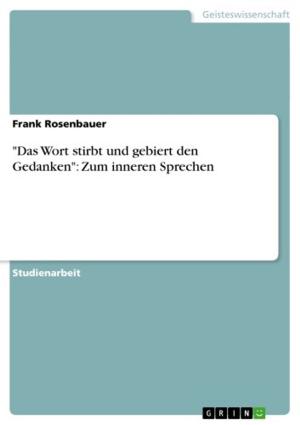The Picture of the individual and of society in Allen Ginsberg's 'Howl' and the Beat Generation's impact on democracy in America
Nonfiction, Entertainment, Drama, Anthologies| Author: | Patrick Wedekind | ISBN: | 9783640198375 |
| Publisher: | GRIN Verlag | Publication: | October 28, 2008 |
| Imprint: | GRIN Verlag | Language: | English |
| Author: | Patrick Wedekind |
| ISBN: | 9783640198375 |
| Publisher: | GRIN Verlag |
| Publication: | October 28, 2008 |
| Imprint: | GRIN Verlag |
| Language: | English |
Seminar paper from the year 2008 in the subject American Studies - Literature, grade: 1,3, Johannes Gutenberg University Mainz, course: Democratic Vistas in American Cultural History, 7 entries in the bibliography, language: English, abstract: Allen Ginsberg's poem 'Howl', considered one of the most influential works of the Beat Generation, was published in 1956. At that time, American society was shaped by the Korean War, the Cold War, and of course McCarthyism, which was a result of the Cold War. These events led to a very conservative and intolerant society, and thus to the development of a counterculture, including the Beat Generation writers as well as other people protesting against this society. In 'Howl', Ginsberg focuses primarily on different individuals, and on society's impact on them. These individuals whom he calls 'the best minds of [his] generation' are people at the edges of society, for example drug addicts, homosexuals, and the mentally ill. Their life and suffering is intensively portrayed in part I of the poem, while part II is mainly dedicated to the 'Moloch' (Howl, 221), i.e. the society these people as well as Ginsberg live in. However, part II not only portrays the 'Moloch' but also describes its influence on the individuals Ginsberg mentions in part I. The third and last part of 'Howl' is dedicated to Ginsberg's friend Carl Solomon living in a mental institution. Due to this clear focus, 'Howl' is particularly useful to get an insight of the way the Beats used to see the individual, American society, and the connection between the two. That is why a detailed analysis of 'Howl' is very helpful to get a better understanding of the Beat Movement, and the way American society used to be in the 1950s and 1960s. Moreover, it is interesting how closely connected the Beat Generation was to the concept of democracy although it seemed to be a rather anarchistic movement rejecting all of society's values. Such democratic aspects within the movement can also be found in 'Howl'.
Seminar paper from the year 2008 in the subject American Studies - Literature, grade: 1,3, Johannes Gutenberg University Mainz, course: Democratic Vistas in American Cultural History, 7 entries in the bibliography, language: English, abstract: Allen Ginsberg's poem 'Howl', considered one of the most influential works of the Beat Generation, was published in 1956. At that time, American society was shaped by the Korean War, the Cold War, and of course McCarthyism, which was a result of the Cold War. These events led to a very conservative and intolerant society, and thus to the development of a counterculture, including the Beat Generation writers as well as other people protesting against this society. In 'Howl', Ginsberg focuses primarily on different individuals, and on society's impact on them. These individuals whom he calls 'the best minds of [his] generation' are people at the edges of society, for example drug addicts, homosexuals, and the mentally ill. Their life and suffering is intensively portrayed in part I of the poem, while part II is mainly dedicated to the 'Moloch' (Howl, 221), i.e. the society these people as well as Ginsberg live in. However, part II not only portrays the 'Moloch' but also describes its influence on the individuals Ginsberg mentions in part I. The third and last part of 'Howl' is dedicated to Ginsberg's friend Carl Solomon living in a mental institution. Due to this clear focus, 'Howl' is particularly useful to get an insight of the way the Beats used to see the individual, American society, and the connection between the two. That is why a detailed analysis of 'Howl' is very helpful to get a better understanding of the Beat Movement, and the way American society used to be in the 1950s and 1960s. Moreover, it is interesting how closely connected the Beat Generation was to the concept of democracy although it seemed to be a rather anarchistic movement rejecting all of society's values. Such democratic aspects within the movement can also be found in 'Howl'.















